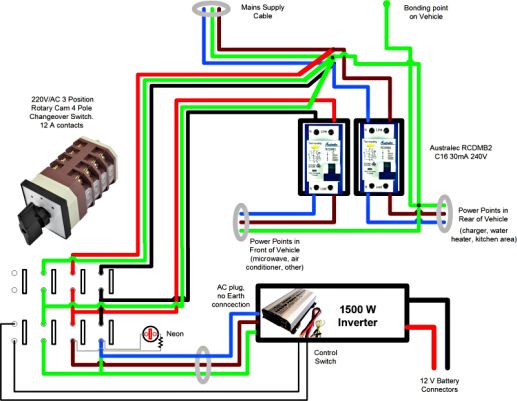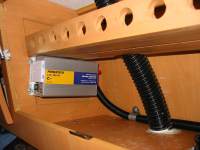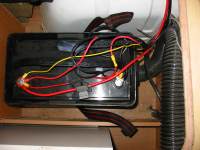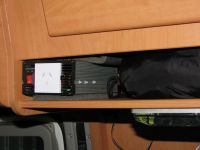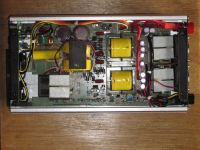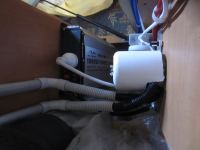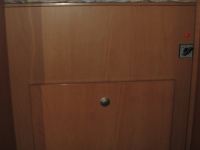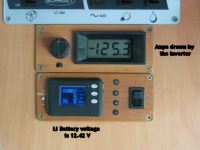
Inverters
There is a place for small and large inverters in the Applause, the size matched to the load.
300W MSW Inverter
A Powertech 12 V 300 W modified square wave inverter from Jaycar is fitted to the side wall of Cupboard 7, above the sink. This is used to run a small plunge mixer and whatever else needs a bit of 240 V power there. I found the Waeco 100 W can inverter I had been quite happy with simply did not have enough surge capacity to start the mixer.
The wiring is 8 AWG (actually 7 x 95/0.12 mm Jaycar WH3062). I am using the 30 A fuse block that came with the inverter, changing the wiring from the supplied 12 AWG, and fitting ring connectors to each end of the new wiring. Initially the wiring connected directly to the house battery, as shown in a photograph. (Compare the battery wiring here with later changes made.)
300W PSW Inverter
A "PS 300" 12 V 300 W pure sine wave inverter is fitted to the shelf above the table behind the driver's seat. Costing little more than a MSW inverter, this unit is from an eBay seller and is used to charge our Netbook computer when off mains electricity, and anything else in that area such as the air cooling fan.
This particular inverter consumes no current when switch off and has a fan that only runs when the unit heats up. Initial tests showed when the inverter was operating there was a large voltage drop on the wiring I had previously installed for the air cooling fan; new wiring was required.
As discussed in the Web page on 12 V rewiring, a trunk line of twin sheathed 6 AWG was run from the battery board to the Technical Cupboard and then across the van under the microwave oven to a junction on the front wall of Cupboard 1. The Inverter, Entertainment System supply, cigarette lighter socket supply and cupboard lighting wiring (8 AWG, 12 AWG, 12 AWG and 22 AWG respectively) connect to this junction and pass into the cupboard.
1500W PSW Inverter
Sept2013: With the installation of a Lithium battery, it becomes possible to consider big ideas for appliances in the van. In particular much of the year my wife would like to be able to heat a wheat bag for foot warming at night. The microwave oven does this job when on mains power and it can also do it on the Lithium battery. The oven is rated at 850W and I measured 1380W input using a power meter. This is around 115A at 12 V, 1.1C and well within the capability of a 100Ah Lithium.
After some searching I purchased an ABR-Sidewinder 1500W PSW Inverter for $315.00 at auction (saving $100 on the Buy-it-Now price) from derek on eBay . Unlike too many other lower priced inverters on eBay, this one is rated 1500W maximum continuous output power. The surge power is said to be 3000W for up to 10s: this is very important in starting up inductive loads like a microwave or power drill. It also has a nice digital display, USB port and is compact enough to fit in the limited space available.
A test showed that when off, the inverter consumes about 20mA; when on standby, about 1.2A. The microwave runs on full power, starting up without a problem. The inverter says it is producing 1410W, with an input voltage of 11.7V. The battery monitor says after 5 minutes running, 12.01V with cell voltages of 3.03–2.98V and a current of 130A through the 100A shunt (it got rather hot!). The fans in the inverter (there are three) are quiet and run all the time the inverter is on. An hour after the load was removed, the battery cell voltages were 3.310–3.305V.
[Dec2013: Two things have happened with further use of the 1500W inverter and the Li battery. (1)The electrical consumption of the inverter has increased for the same power output. Presumably this is due to aging of components. (2) The lithium battery is holding its voltage better under high load - its internal resistance has decreased. Now under full load the battery voltage holds to 12.4V, up from 12.0V, and the current draw is 125A for a power input of 1550W. Some power is lost in the wiring, but the inverter is using over 1520W.]
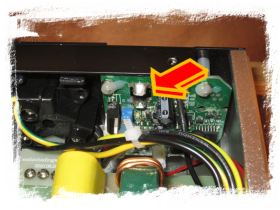
These data show the inverter efficiency at full power is a credible 88%. There is a voltage drop of 100mV along each of the supplied power cables. There is 48mV drop across the 200A fuse and 40mV along the cables from the battery to the fuse and neutral junction.
I passed a light twin flex through a vent next to the USB port on the front of the inverter and soldered it to each of the two terminals on the main power switch (arrowed in the photo). Remotely shorting the wires causes the inverter to turn on.
Apr2014: I have changed the microwave to an Aldi 700W version, thereby reducing the battery load to 100A (which is a woeful efficiency) so that the inverter has some margin to operate below its rated maximum.
Wiring in the Inverter
This is a record of what has been done. It is NOT a recommendation for others to
follow.
A qualified electrician should be employed to work on mains wiring.
The mains power system in the Applause is divided into two, each controlled by its own Residual Current Breaker and Overload switch: (i) all the front power points, including the outside one, and (ii) the rear power points (including the battery charger) under the bed, the hot water service, and the power point next to the bed in the kitchen area. By connecting the inverter only to the RCBO for the front circuits we avoid having to remember to turn off the hot water service and the battery charger, which are normally left on, ready to work when plugged in to a mains supply.
Fig 3.1 of AS/NZ3001-2008 requires that an isolated inverter must be installed ahead of the RCBO, must have both the active and neutral switched, and have its neutral switched to chassis bond when activated using a break-before-make changeover switch. This ensures that the RCBO continues to provide residual current detection and protection when supply is from the inverter, though why the inverter "earth" needs to be switched instead of permanently connected to chassis bond escapes me.
A four pole three position rotary cam switch allows Active, Neutral and Earth to be switched, as well as turning on the inverter at the same time. eBay seller UXCELL supplied a quality unit for a good price.
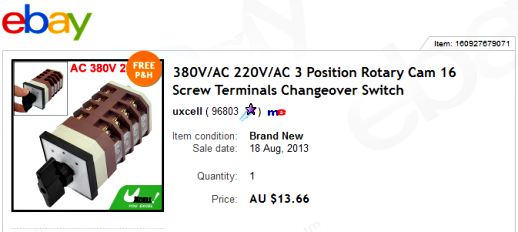
The wiring diagram shows the connections for the rotary switch; it includes a neon that indicates when 'inverter on'.
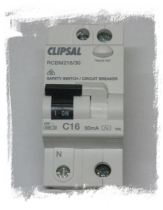
As an aside is the finding that the vehicle bonding point, made when the mains wiring was originally installed, consisted of a loose metal screw into painted body steel. I replaced the screw and cleaned the body steel to bare metal and coated it in a conductive grease.
A further aside is that the original RCBO had become extremely sensitive, switching off on occasion even when no loads nor input were connected. It was replaced by a Clipsal RCBM216/30.
The photos show the wiring to the changeover switch from the mains and the inverter, returning to the RCBO; the neon is on top. Left: side view. Right: top view.
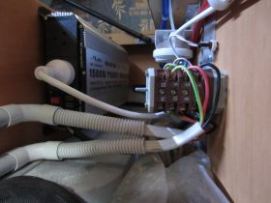
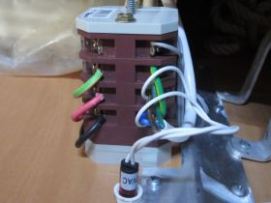
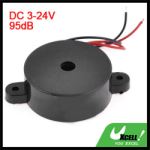
In addition to the neon to show when the inverter is on, I have added a pulsing beeper, from UXCELL on eBay for $5.80. A 9V power supply is plugged into the other socket on the inverter and this is used to drive the beeper. A 390 Ohm resistor is wired across the beeper, otherwise when the inverter is turned off the beeper continues in a frenetic state until the capacitor in the power supply discharges.
LINKS
- Jaycar http://www.jaycar.com.au
- eBay http://www.ebay.com.au
Inverters
300 W MSW inverter installed in cupboard 7, above the sink and stove.
The wiring to the battery as it was. The thickest wires (8 AWG) were added for the MSW inverter.
300 W PSW inverter installed on the shelf above the table.
Inside 1500W PSW inverter. Front on the left.
1500 W PSW inverter and changeover switch (behind cover) installed under the bed.
Red neon shows 1500 W PSW inverter is on.
1500 W inverter powering 850 W microwave. With 0.3 V drop to the inverter, electrical consumption by the inverter is 1520 W.

